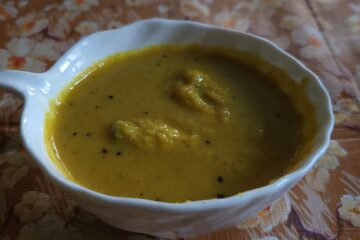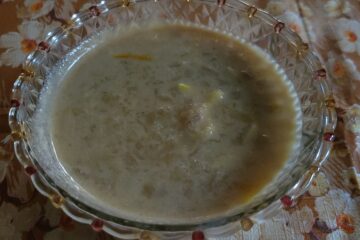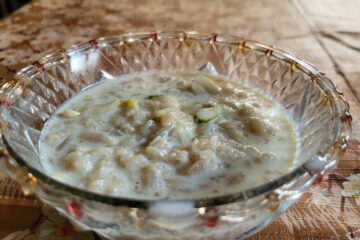Ghota refers to a type of local mango, which is typically peeled and eaten by sucking out the pulp. This traditional Goan dish, known as Ghotache Sasav, is made using these sweet and tangy mangoes. In Konkani, “saasava” means mustard seeds. This dish is characterized by a unique blend of flavours—very slightly bitter from mustard seeds, tangy and sweet from mangoes, and spicy from the chilies added to the coconut paste. Together, these create a dish with a well-rounded taste.
Ingredients and Recipe for Ghota’s Sasav:
- Ghota: (local mangoes): 7-8
- Jaggery: 2 tablespoons (adjust based on the sweetness of the mango)
- dried red chilies: 7-8
- turmeric powder: 1/4 teaspoon
- Grated coconut: 1 large bowl
- mustard seeds:1 teaspoon
- coriander seeds:1 teaspoon
- black peppercorns: 8-10
- Tamarind: A piece the size of a small lemon (skip if the mango is already sweet and tangy)
- Salt to taste
For tempering:
- local coconut oil (or any available oil): 1 tablespoon
- mustard seeds: 1 teaspoon
- asafoetida (hing): A pinch
- curry leaves: 7-8 (optional)
Direction to cook:
- Wash the mangoes thoroughly and peel them.
- Roast the mustard seeds on low heat until they are slightly browned.
- In a mixer jar, add grated coconut, dried red chilies, tamarind, roasted mustard seeds, coriander seeds, black pepper, and turmeric. Add water as needed and grind everything into a fine paste.
- Pour this ground paste into a pan. Add the required amount of water and jaggery, then place it on low heat to cook.
- When it starts to boil, squeeze some juice from the peeled mangoes into the mixture and add the mangoes.
- Let it cook for about 4-5 minutes.
- Meanwhile, prepare the tempering. Heat oil in a small pan, add mustard seeds.
- When they start to splutter, add curry leaves, asafoetida and turn off the heat.
- Add salt to the cooking sasav and then pour in the tempering. Mix well and turn off the heat.
This tangy, sweet, and spicy Ghotache Sasav tastes amazing with chapati.


